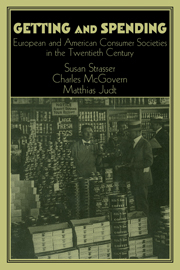Book contents
- Frontmatter
- Introduction
- Part One Politics, Markets, and the State
- Part Two Everyday Life
- 9 World War I and the Creation of Desire for Automobiles in Germany
- 10 Gender, Generation, and Consumption in the United States: Working-Class Families in the Interwar Period
- 11 Comparing Apples and Oranges: Housewives and the Politics of Consumption in Interwar Germany
- 12 “The Convenience Is Out of This World”: The Garbage Disposer and American Consumer Culture
- 13 Consumer Culture in the GDR, or How the Struggle for Antimodernity Was Lost on the Battleground of Consumer Culture
- 14 Changes in Consumption as Social Practice in West Germany During the 1950s
- 15 Reshaping Shopping Environments: The Competition Between the City of Boston and Its Suburbs
- 16 Toys, Socialization, and the Commodification of Play
- 17 The “Syndrome of the 1950s” in Switzerland: Cheap Energy, Mass Consumption, and the Environment
- 18 Reflecting on Ethnic Imagery in the Landscape of Commerce, 1945-1975
- Part Three History and Theory
- Index
12 - “The Convenience Is Out of This World”: The Garbage Disposer and American Consumer Culture
Published online by Cambridge University Press: 05 January 2013
- Frontmatter
- Introduction
- Part One Politics, Markets, and the State
- Part Two Everyday Life
- 9 World War I and the Creation of Desire for Automobiles in Germany
- 10 Gender, Generation, and Consumption in the United States: Working-Class Families in the Interwar Period
- 11 Comparing Apples and Oranges: Housewives and the Politics of Consumption in Interwar Germany
- 12 “The Convenience Is Out of This World”: The Garbage Disposer and American Consumer Culture
- 13 Consumer Culture in the GDR, or How the Struggle for Antimodernity Was Lost on the Battleground of Consumer Culture
- 14 Changes in Consumption as Social Practice in West Germany During the 1950s
- 15 Reshaping Shopping Environments: The Competition Between the City of Boston and Its Suburbs
- 16 Toys, Socialization, and the Commodification of Play
- 17 The “Syndrome of the 1950s” in Switzerland: Cheap Energy, Mass Consumption, and the Environment
- 18 Reflecting on Ethnic Imagery in the Landscape of Commerce, 1945-1975
- Part Three History and Theory
- Index
Summary
“Our disposer came with the house, and I thought it was just a gimmick to increase its cost,” a California housewife told the interviewer for a nationwide survey sponsored by a plumbing and heating trade journal in 1963. “How wrong I was! Once I started using it, it became indispensable. The convenience is out of this world. I'd never give it up, and I can't imagine any woman not wanting one when it's explained to her what it can do.” About 22 percent of the women surveyed used garbage disposers, and most of them shared the California woman's enthusiasm. A Denver woman called hers “a little jewel” that “eliminates trips to my back alley in rain, snow and subzero weather.” A Florida homemaker supplied the hot-weather viewpoint: “I think any woman who lives in a warm climate would be out of her mind not to want a disposer,” she told the interviewer. “We have so many problems with insects. . . . Anything that will cut down on garbage and discourage the appearance of vermin . . . is a godsend.”
The survey responses highlight fundamental issues in the marketing of the electric garbage disposer, a device for grinding food waste that is commonplace in the kitchen sinks of American houses, although it is virtually unknown in Europe. Invented in 1935, its commercial development awaited recovery from World War II, like that of many other consumer products, and the way of life it represents constituted a major postwar transformation.
- Type
- Chapter
- Information
- Getting and SpendingEuropean and American Consumer Societies in the Twentieth Century, pp. 263 - 280Publisher: Cambridge University PressPrint publication year: 1998
- 1
- Cited by



